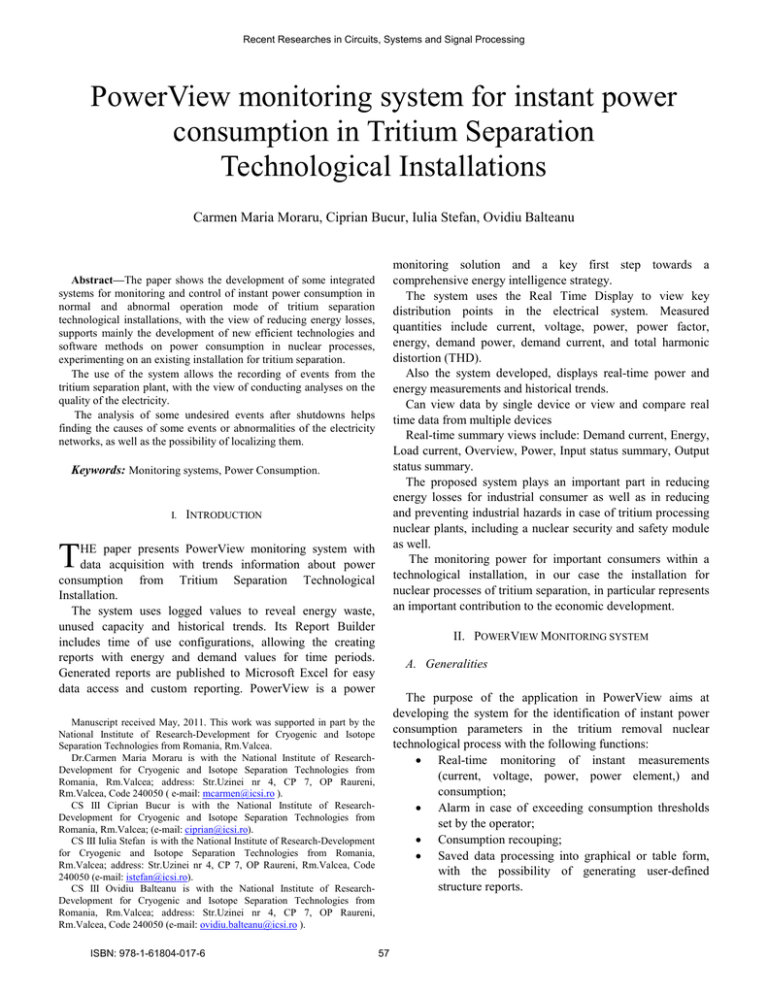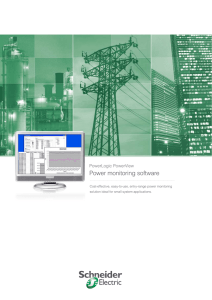PowerView monitoring system for instant power
advertisement

Recent Researches in Circuits, Systems and Signal Processing PowerView monitoring system for instant power consumption in Tritium Separation Technological Installations Carmen Maria Moraru, Ciprian Bucur, Iulia Stefan, Ovidiu Balteanu monitoring solution and a key first step towards a comprehensive energy intelligence strategy. The system uses the Real Time Display to view key distribution points in the electrical system. Measured quantities include current, voltage, power, power factor, energy, demand power, demand current, and total harmonic distortion (THD). Also the system developed, displays real-time power and energy measurements and historical trends. Can view data by single device or view and compare real time data from multiple devices Real-time summary views include: Demand current, Energy, Load current, Overview, Power, Input status summary, Output status summary. The proposed system plays an important part in reducing energy losses for industrial consumer as well as in reducing and preventing industrial hazards in case of tritium processing nuclear plants, including a nuclear security and safety module as well. The monitoring power for important consumers within a technological installation, in our case the installation for nuclear processes of tritium separation, in particular represents an important contribution to the economic development. Abstract—The paper shows the development of some integrated systems for monitoring and control of instant power consumption in normal and abnormal operation mode of tritium separation technological installations, with the view of reducing energy losses, supports mainly the development of new efficient technologies and software methods on power consumption in nuclear processes, experimenting on an existing installation for tritium separation. The use of the system allows the recording of events from the tritium separation plant, with the view of conducting analyses on the quality of the electricity. The analysis of some undesired events after shutdowns helps finding the causes of some events or abnormalities of the electricity networks, as well as the possibility of localizing them. Keywords: Monitoring systems, Power Consumption. I. INTRODUCTION T HE paper presents PowerView monitoring system with data acquisition with trends information about power consumption from Tritium Separation Technological Installation. The system uses logged values to reveal energy waste, unused capacity and historical trends. Its Report Builder includes time of use configurations, allowing the creating reports with energy and demand values for time periods. Generated reports are published to Microsoft Excel for easy data access and custom reporting. PowerView is a power II. POWERVIEW MONITORING SYSTEM A. Generalities The purpose of the application in PowerView aims at developing the system for the identification of instant power consumption parameters in the tritium removal nuclear technological process with the following functions: • Real-time monitoring of instant measurements (current, voltage, power, power element,) and consumption; • Alarm in case of exceeding consumption thresholds set by the operator; • Consumption recouping; • Saved data processing into graphical or table form, with the possibility of generating user-defined structure reports. Manuscript received May, 2011. This work was supported in part by the National Institute of Research-Development for Cryogenic and Isotope Separation Technologies from Romania, Rm.Valcea. Dr.Carmen Maria Moraru is with the National Institute of ResearchDevelopment for Cryogenic and Isotope Separation Technologies from Romania, Rm.Valcea; address: Str.Uzinei nr 4, CP 7, OP Raureni, Rm.Valcea, Code 240050 ( e-mail: mcarmen@icsi.ro ). CS III Ciprian Bucur is with the National Institute of ResearchDevelopment for Cryogenic and Isotope Separation Technologies from Romania, Rm.Valcea; (e-mail: ciprian@icsi.ro). CS III Iulia Stefan is with the National Institute of Research-Development for Cryogenic and Isotope Separation Technologies from Romania, Rm.Valcea; address: Str.Uzinei nr 4, CP 7, OP Raureni, Rm.Valcea, Code 240050 (e-mail: istefan@icsi.ro). CS III Ovidiu Balteanu is with the National Institute of ResearchDevelopment for Cryogenic and Isotope Separation Technologies from Romania, Rm.Valcea; address: Str.Uzinei nr 4, CP 7, OP Raureni, Rm.Valcea, Code 240050 (e-mail: ovidiu.balteanu@icsi.ro ). ISBN: 978-1-61804-017-6 57 Recent Researches in Circuits, Systems and Signal Processing -Building automation – Initiate a direct Ethernet connection to the existing LAN/WAN configuration and maximize the return on the investment. -Factory automation – Obtain a full view of the power system with remote monitoring and increase system performance on alarms and data transfers. In Figure 1 is presented a block diagram with EGX system architecture with connections between computer and Power Meter 710 used in Tritium Removal Installation. B. Hardware System Components The functional model for the monitoring system of electric energy consumption has been initially implemented for these groups of consumers from Tritium Removal Installation presented below: -Compressor - K301 -General Power plant - TGD -Generator - GE Electrical parameters of the three consumers are acquired by the power devices, Power Meter 710 with RS 485 network connected to the Operator Station Monitoring System. Mounting the Power Meter 710 was made in existing switchboards Electrical Room from Tritium Removal Installation. The electrical connections on the current measurement were accomplished by current transformers. Also, the connection between the computer and Power Meter PM 710 was achieved using Power Logic EGX100 gateway module. From a single building to a multi-site enterprise, PowerLogic Web-Enabled Network Components provide fast, reliable serial line to Ethernet connectivity in the most applications. PowerLogic Ethernet Gateways are available in two models - EGX100 and EGX400 -providing direct connection to Ethernet-Modbus®/TCP networks to make energy and power monitoring information available over local and wide area networks. The EGX100, used in our application on tritium removal installation, provides low-cost, reliable, Ethernet to serial-line connectivity in a compact, DIN-rail mounted package. Enabled by Power over Ethernet (PoE IEEE 802.3af), the EGX100 simplifies installation by eliminating the need for power supplies plus provides a Web-based interface for configuration and diagnostics. The PowerLogic EGX100 Ethernet gateway helped us to reduce the cost and complexity of connecting, configuring and managing a network of intelligent meters, sensors and other remote instruments [3]. The entry-level PowerLogic EGX100 enables users to configure Ethernet and serial communication parameters, add devices to a network and perform troubleshooting through a web interface with detailed diagnostics. The PowerLogic EGX100 supports 10BaseT and 100BaseTX and is suitable for a wide range of applications including: -Energy efficiency and cost control – Access usage consumption from piped utilities and power equipment data from power meters, circuit breaker trip units, programmable controllers, drives and protective relays. -Sub-billing and cost allocation – Add devices across a TCP/IP network even if the building management system only has a Modbus serial interface. -Power distribution – Applied directly to power distribution equipment and monitor and control devices that do not have a native Ethernet communications port ISBN: 978-1-61804-017-6 Figure 1: EGX100 system architecture Model PM710 meters offer a standard RS-485 communication port that allows data to be uploaded to software for viewing and analysis. The port offers 2-wire connection, operates at speeds up to 19.2 bauds, and supports Modbus RTU protocol [5]. Also the PM710 meters are compatible with PowerLogic facility-level or enterprise-wide power and energy management systems. Real-time and min/max data can be automatically retrieved for analysis at the system level, compatible with PowerLogic ION Enterprise, PowerLogic System Manager, PowerLogic PowerView and PowerLogic Tenant Metering software. Modbus compatibility supports integration with building automation, SCADA and other thirdparty systems. Metering is performed by zero-blind sampling and all inputs are at the 32 samples/cycle with a data update rate of 1 second. The meter offers a range of instantaneous RMS, power, demand and energy measurements suitable for real-time monitoring, energy management and sub-billing purposes. In Figures 2 and 3 are presented front views of the PM 700 series. 58 Recent Researches in Circuits, Systems and Signal Processing PowerView power monitoring software simplifies system and device configuration by polling the network for compatible PowerLogic devices. Connection and data logging begins automatically at factory preset interval settings, which are user configurable. The software allows tracking real-time power conditions and performing remote monitoring of electrical equipment or installations at key distribution points across the electrical network. Software is easy-to-use selective and scan component for quick and easy device detection, also select up to 32 devices to add to the system – or manually add/delete devices. The onboard device logging or PC-based logging (depending upon device capabilities) begins automatically at default or user-defined intervals. We use Microsoft SQL Server 2005 Express Edition with Advanced Services database with backup/restore capabilities for reliable database management. Real Time System is used to view the key points of distribution in the electrical system. Measured quantities include current, voltage, power factor, energy, power required and total harmonic distortion (THD). For an electrical appliance, the information stored in the file daily report is presented below: -address of the measure -measuring point name -date and hour, minute, second -active energy- sum of the three phases -reactive energy- sum of the three phases -cost of energy for the three phases -active power at that time for the sum of the three phases -reactive power at that time for the sum of the three phases -maximum voltage on R, S, T phases -active and reactive power on phases R, S, T -active and reactive energy on phases R, S, T Viewing and printing system provided the following types of reports: -Specifically Report - 8 hours (or 12 hours) -Daily report (24 hours) -Monthly Report -Annual report To achieve the monitoring software was required the Power View initial configuration and equipment used by Power Meter PM 710 and EGX-100 module for connecting the computer to the module PM 710. Initial IP address was set via module PM 710 and the Start Scan command is given, with view system configuration and related modules. Figure 4 present the PowerView mode configuration. Figure 2: PM700 series meter front view showing integrated display. Figure 3: Front View from Power Meter 700 series with measurements All models PM 700 series offer also the total harmonic distortion measurement (THD) on voltage and current, per phase and min/max. C. Software System PowerView ISBN: 978-1-61804-017-6 59 Recent Researches in Circuits, Systems and Signal Processing Figure 5 Initial configurations in PowerView Figure 4: PowerView mode configuration We used the command "Report Builder" to build and generate reports of measurements and graphs in Microsoft Excel (Figure 6 and 7). Standard reports include: -General Measurement - models trend to use electricity, energy or any other parameter required logged. -Consumption of energy per day, energy consumption per hour - analysis kilowatt / hour measured in cost allocation purposes. -THD-quantitative - measuring, analyzing and comparing the total harmonic distortion -Time-use (TOU) - set up to three programs each with 10 periods of TOU energy storage, weekend, special days, and holidays. PowerView software simplifies the management by selecting the network address, connection compatible PowerLogic devices and interface protocols are in the Modbus TCP / IP way. Real Time System is used to view the key points of distribution in the electrical system. Measured quantities include current, voltage, power factor, energy, power required and total harmonic distortion (THD). In Figure 5 is presented the layout of the initial configuration of the electrical parameters measured in the Power View. ISBN: 978-1-61804-017-6 60 Recent Researches in Circuits, Systems and Signal Processing REFERENCES [1] Golovanov, N., Postolache, P., Toader, C., - Eficienta si Calitatea Energiei Electrice, Editura AGIR, Bucuresti, 2007. [2] Gheorghe, St., Postolache, P., Branescu, V., Ene, S., Mihaescu, M., Ivan, M. – Monitorizarea calitatii energiei electrice. Editura Macarie, Târgoviste, 2001. [3] “PowerLogic selection guide and technical overview”, Schneider Electric, dec. 2003. [4] “Electrical network management-PowerLogic System-Catalogue 2009”, Schneider Electric, feb. 2009. [5] “Power Meter 710-Reference Manual-63230-501-209A1”, Schneider Electric, iul. 2008. [6] “Power Meter 710-Installation Guide-63230-501-206A1”, Schneider Electric, iul. 2008. [7] Seip, G. Siemens - Electrical Installations Handbook, part 2, cap. 7 Power-factor correction, Ed. 2, 1987 [8] *** Normativ pentru proiectarea si executarea instalatiilor electrice cu tensiuni pâna la 1000 Vc.a. si 1500 V c.c. - indicativ I 7-02, cap. 7.1 [9] *** Instructiuni privind compensarea puterii reactive în retelele electrice de distributie si la consumatorii industriali si similari, indicativ PE 120 [10] Prospect FRAKO - Reactive Power Control Relay Model RM 9606 [11] Prospect SIEMENS - Power Factor Correction, Basic principles, practical application, harmonic suppression Figure 6: Reports in PowerView of point measurements, K301, TGD and GE from Tritium Removal Installation 10.00 9.00 8.00 User Topics 7.00 6.00 5.00 4.00 3.00 2.00 1.00 .00 4/14/2011 1:00 PM 4/14/2011 1:15 PM Date/Time GE:Apparent Power Total GE:Current A Figure 7: Graph with data acquisitions in PowerView III. CONCLUSIONS The PowerLogic system with PowerView software used in Tritium Removal Installation allows the measurement and monitoring of power and energy consumption at any level from a supply network and power distribution. Energy management of an installation (consumption in different sectors) is the process of monitoring, coordination and control of these inputs in order to ensure efficient consumption of energy by reducing energy losses and thus minimize energy costs. Also, the research in the field of monitoring power for important consumers within a technological installation, represents an important contribution to the economic development by means of increased energy efficiency of the entire energy chain. ISBN: 978-1-61804-017-6 61





